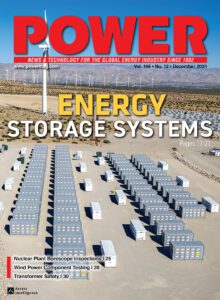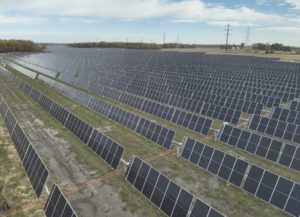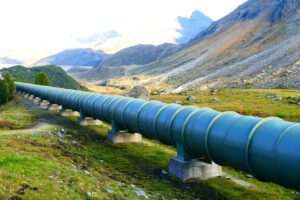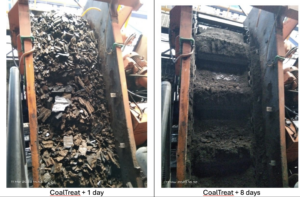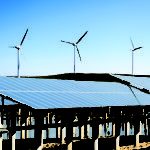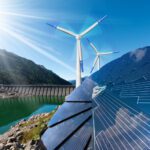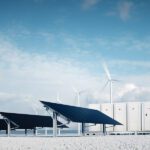Egypt Reducing Renewable Energy Target. Karim Badawi, petroleum minister for Egypt, said the country has cut the amount of renewable energy it will likely have online by 2040. Badawi on Oct. 20, speaking at the Mediterranean Energy Conference, said Egypt’s target for renewables is now 40% by 2040, down from the 58% goal it had set in summer 2023. The International Energy Agency said that as of 2022 the country generated just more than 10% of its power from renewables (mostly hydropower), with 80% coming from burning natural gas. Badawi said Egypt will now focus on investments that hold “more wealth, particularly natural gas.” Egypt hosted the COP27 climate summit in 2022, and at that time officials pledged to increase power generation from renewables to 42% of the country’s energy mix by 2035. Badawi said his ministry wants to increase the use of natural gas, and exports of petroleum products including gas, to $8.6 billion annually. There are major renewable energy projects underway in Egypt. Masdar, a clean energy developer based in the United Arab Emirates, plans a 10-GW renewables project. ENGIE also is working with the Egyptian government on development of a 3-GW onshore wind farm.
UK Group Supporting Long-Duration Energy Storage. The UK’s Department for Energy Security and Net Zero (DESNZ) in October confirmed development of a new program designed to stimulate investment in the country’s long-duration energy storage sector. Department officials said the scheme, with a cap-and-floor mechanism, will “remove barriers which have prevented the building of new storage capacity for nearly 40 years.” Ofgem, the UK’s energy regulator, has been chosen to design and deliver the first round of a cap-and-floor mechanism for storage technology. The program is expected to provide revenue certainty for investors by guaranteeing revenues above an agreed floor. It also would offer protection to consumers by limiting revenues to an agreed cap. The program will have two application routes, with one focused on mature technologies, while the other will support new innovation. DESNZ said the first round of the cap-and-floor model is expected to be open to applicants in 2025. Utility SSE said the 1.3-GW Coire Glas pumped-hydro storage project in Scotland is among the installations that could now move forward thanks to the program.
An Economical, Environmentally Friendly Hydraulic Fluid. Renewable Lubricants recently introduced biodegradable Bio-Fleet Hydraulic Fluids, which perform like synthetics but are economical enough for frequent oil change environments. These patented formulations meet or exceed common performance protocols. Highly inhibited against moisture and rusting in both fresh and sea water, they are ideal for hydraulic equipment operating outside where high-moisture and dusty environments are prominent. Bio-Fleet Hydraulic Fluids should be used in hydraulic systems where low toxicity, biodegradability, and non-bioaccumulation properties are required. They are safer for both the environment and the employees working with and around them. They also have a significantly higher flash point than traditional hydraulic fluids, so they are much safer around hot running equipment.
Italy-Based Company Invests €32.6 Million in Solar Power Developments. GreenGo, a Bologna, Italy-based energy company, received €32.6 million ($34.4 million) of financial support from Italian banking group Intesa Sanpaolo. The money will be used to help build eight solar farms in Calabria, Sicily, and Marche. The investment is part of an €8 billion ($8.4 billion) fund made available by Intesa Sanpaolo to support energy infrastructure. GreenGo specializes in the design and construction of large-scale renewable energy facilities. The eight plants, with total generation capacity of 41.8 MW, include four in Calabria (22.8 MW in total), three in Sicily (13.7 MW), and one in Marche (5.3 MW). The project contains a mixed commercial portfolio comprising corporate power purchase agreements with Sasol Italia Spa (47%), incentive tariffs from the GSE (17%), and a full merchant model (36%) for the sale of electricity produced by the plants. The eight facilities are under construction and expected to become operational in the first half of 2025. The transaction was finalized by Intesa Sanpaolo’s Banca dei Territori division along with the IMI Corporate & Investment Banking division. The Circular Economy Desk of Intesa Sanpaolo Innovation Center, the group’s unit dedicated to innovation and promoting the circular economy model, also collaborated on the credit line. GreenGo has a development plan that expects to receive more than €300 million ($316 million) in investments by 2026. The company wants to expand its generation capacity for solar, wind, and energy storage by more than 350 MW. The company at present has a renewable energy pipeline of more than 1,800 MW.
Siemens Gamesa Completes Work on Taiwan Offshore Wind Farm. Siemens Gamesa in mid-October said it has successfully installed the final turbine at the 640-MW Yunlin Offshore Wind Farm. The Yunlin project off the coast of Taiwan includes 80 SG 8.0-167 DD turbines. The installation also features Taiwan’s first domestically produced wind turbine towers, manufactured in collaboration with CS Wind and Chin Fong Machine Industrial at Taichung Harbour. Siemens Gamesa’s partners in the project include Germany-based Skyborn Renewables, along with local equipment suppliers and the Taiwanese government. The project was developed by Yunneng Wind Power, a subsidiary of Skyborn Renewables. Construction began in 2020, with the first of the 80 turbines installed in April 2021. The offshore wind farm has a 20-year power purchase agreement with Taipower.
Developer Plans 122-MW Wind Farm in Ireland. Developer FuturEnergy Ireland in October said it plans to build a 122-MW wind farm in Ireland. FuturEnergy Ireland, a joint venture of utility ESB, forestry company Coillte, and SSE Renewables, a unit of UK utility SSE plc, announced the groups have submitted a planning application to An Bord Pleanala for the Cummeennabuddoge wind farm, which would feature 17 turbines and be located close to Ballyvourney, near the border between Cork and Kerry counties. The planning submission follows consultation with local communities that began in late 2020, according to the principles. FuturEnergy has about 20 wind power projects across Ireland. ■
—Darrell Proctor is a POWER senior editor.


